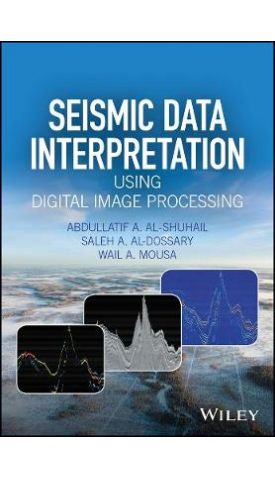אנו משתמשים ב-Cookies כדי לשפר את החוויה שלך. כדי לקיים ההנחיה החדשה של e-Privacy, עלינו לבקש את הסכמתך להגדיר את ה-Cookies. קבלת מידע נוסף.
540.00 ₪
Seismic Data Interpretation using Digital Image Processing
540.00 ₪
ISBN13
9781118881781
יצא לאור ב
New York
זמן אספקה
21 ימי עסקים
עמודים
178
פורמט
Hardback
תאריך יציאה לאור
25 באוג׳ 2017
Bridging the gap between modern image processing practices by the scientific community at large and the world of geology and reflection seismology This book covers the basics of seismic exploration, with a focus on image processing techniques as applied to seismic data.
Bridging the gap between modern image processing practices by the scientific community at large and the world of geology and reflection seismology This book covers the basics of seismic exploration, with a focus on image processing techniques as applied to seismic data. Discussions of theories, concepts, and algorithms are followed by synthetic and real data examples to provide the reader with a practical understanding of the image processing technique and to enable the reader to apply these techniques to seismic data. The book will also help readers interested in devising new algorithms, software and hardware for interpreting seismic data. Key Features: * Provides an easy to understand overview of popular seismic processing and interpretation techniques from the point of view of a digital signal processor. * Presents image processing concepts that may be readily applied directly to seismic data. * Includes ready-to-run MATLAB algorithms for most of the techniques presented.
The book includes essential research and teaching material for digital signal and image processing individuals interested in learning seismic data interpretation from the point of view of digital signal processing. It is an ideal resource for students, professors and working professionals who are interested in learning about the application of digital signal processing theory and algorithms to seismic data.
| עמודים | 178 |
|---|---|
| פורמט | Hardback |
| ISBN10 | 1118881788 |
| יצא לאור ב | New York |
| תאריך יציאה לאור | 25 באוג׳ 2017 |
| תוכן עניינים | Foreword iii Preface xi 1 Introduction 1 1.1 Image Processing of Exploration Seismic Data 1 1.2 Exploration Seismic Data: From Acquisition to Interpretation 1 1.2.1 Seismic Data Acquisition 2 1.2.2 Seismic Data Processing 2 1.2.3 Seismic Data Interpretation 2 1.3 The Seismic Convolution Model 3 1.4 Summary 4 2 Seismic Data Interpretation 7 2.1 Introduction 7 2.2 Structural Features 12 2.2.1 Faults 12 2.2.2 Folds 23 2.2.3 Diapirs 23 2.3 Stratigraphic Features 23 2.3.1 Channels 28 2.3.2 Reefs 28 2.3.3 Truncation 28 2.4 Seismic interpretation Tools 34 2.4.1 Seismic Sequence Stratigraphy 34 2.4.2 Seismic Facies Analysis 40 2.4.3 Direct Hydrocarbon Indicators (DHI) 40 2.4.4 Tying Seismic and Well Data 49 2.4.5 Seismic Modeling 50 2.4.6 Time-to-Depth Conversion 51 2.4.7 Seismic Attributes 53 2.5 pitfalls in Seismic Interpretation 56 2.6 Summary 62 2.7 Problems and Computer Assignments 64 3 Seismic Image Enhancement in the Spatial Domain 79 3.1 Introduction 79 3.1.1 The Mean (Running Average) Filter 80 3.2 The Median Filter 83 3.3 The edge preserving smoothing algorithm 85 3.3.1 2D structure-preserving smoothing 87 3.4 Wavelet Based Smoothing 90 3.4.1 Method 90 3.4.2 Sharpening Filter 94 3.5 Summary 94 3.6 Problems and Computer Assignments 96 4 Seismic Image Enhancement in the Spectral Domain 99 4.1 Introduction 99 4.2 The Fourier Transform 99 4.3 Filtering in the Spectra Domain 103 4.4 Spectral Attributes 103 4.5 Summary 105 4.6 Problems and Computer Assignments 106 5 Seismic Attributes 109 5.1 Introduction 109 5.2 Detection of interesting regions from time or depth 3D slices using seismic attributes 109 5.3 2D Numerical gradients edge detectors operators 111 5.4 Application to Real Seismic Data 114 5.5 2D Second order Derivative Operator 114 5.5.1 The coherence attribute 121 5.5.2 The dip attribute 124 5.6 The curvature attribute 126 5.7 Curvature of the Surface 129 5.7.1 Curve, velocity and curvature 129 5.7.2 Surface, tangent plane and norm 130 5.8 Shape operator, normal curvature and principal curvature 131 5.8.1 Normal curvature 131 5.8.2 Shape operator 132 5.8.3 The principal curvatures 132 5.8.4 Summary of calculation of principal curvature for a surface 133 5.9 The Randomness attribute 134 5.10 Technique for Two Dimensional Image 135 5.10.1 Problem Statement and Preliminaries 135 5.10.2 Review of Fast Noise Variance Estimation Algorithm 137 5.10.3 Design Mask by Constrained Optimization 137 5.11 The Spectral Decomposition attribute 140 5.12 Summary 143 5.13 Problems and Computer Assignments 144 6 Color Display of Seismic Images 151 6.1 Introduction 151 6.2 Color Models and Useful Color Bars 153 6.2.1 The RGB Model 153 6.2.2 The CMY Model 154 6.2.3 The HSI Model 154 6.2.4 Useful Color Bars 156 6.3 Overlay and Mixed Displays of Seismic Attribute Images 157 6.4 Summary 158 6.5 Problems and Computer Assignments 159 7 Seismic Image Segmentation 163 7.1 Introduction 163 7.2 Basic Seismic Image Segmentation 164 7.3 Advanced Seismic Image Segmentation 165 7.3.1 Color Based Segmentation 165 7.3.2 Graph-based Segmentation 168 7.4 Automatic Fault Extraction 169 7.5 Summary 170 Glossary 177 Index 183 |
| זמן אספקה | 21 ימי עסקים |



Login and Registration Form